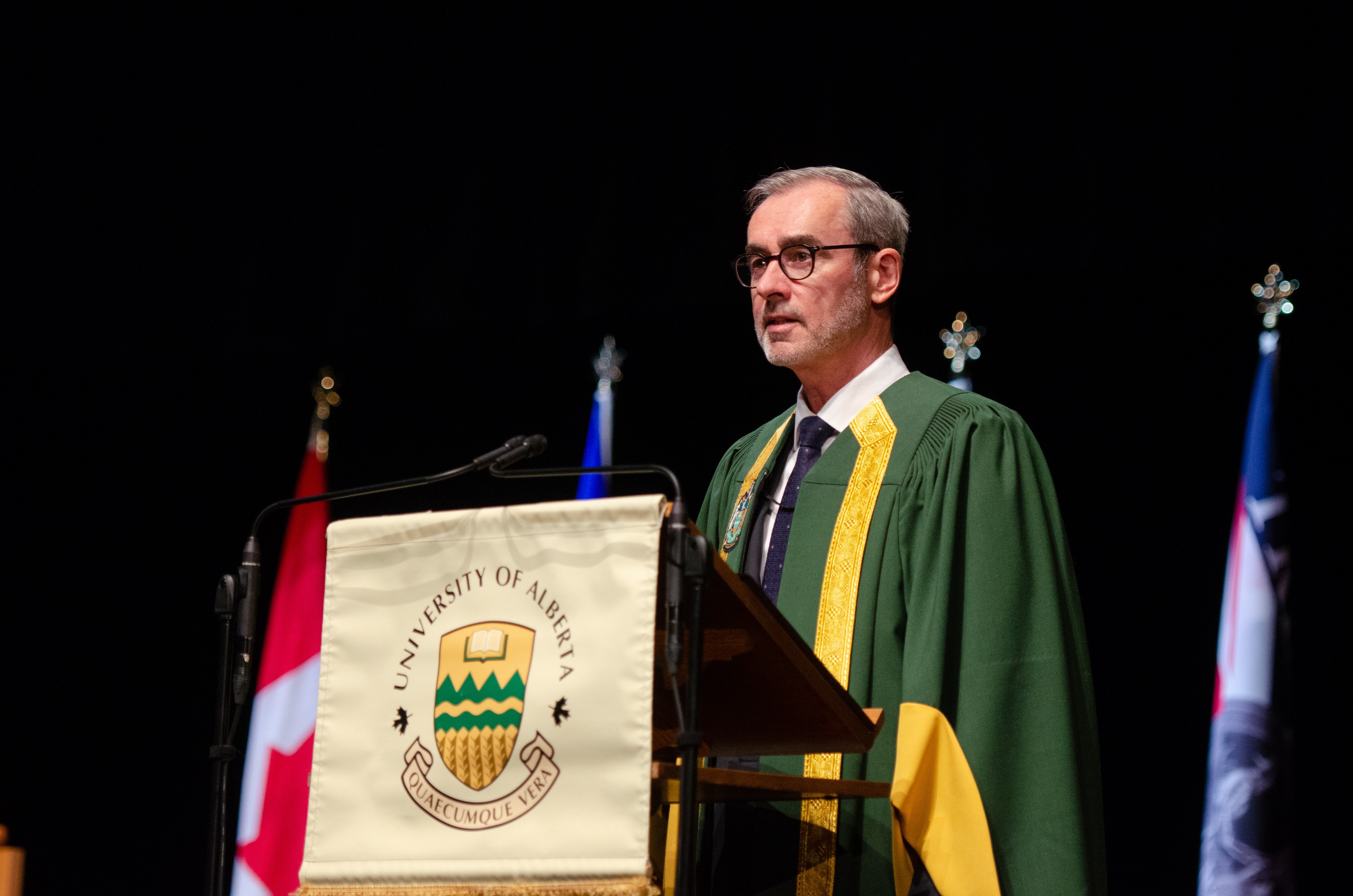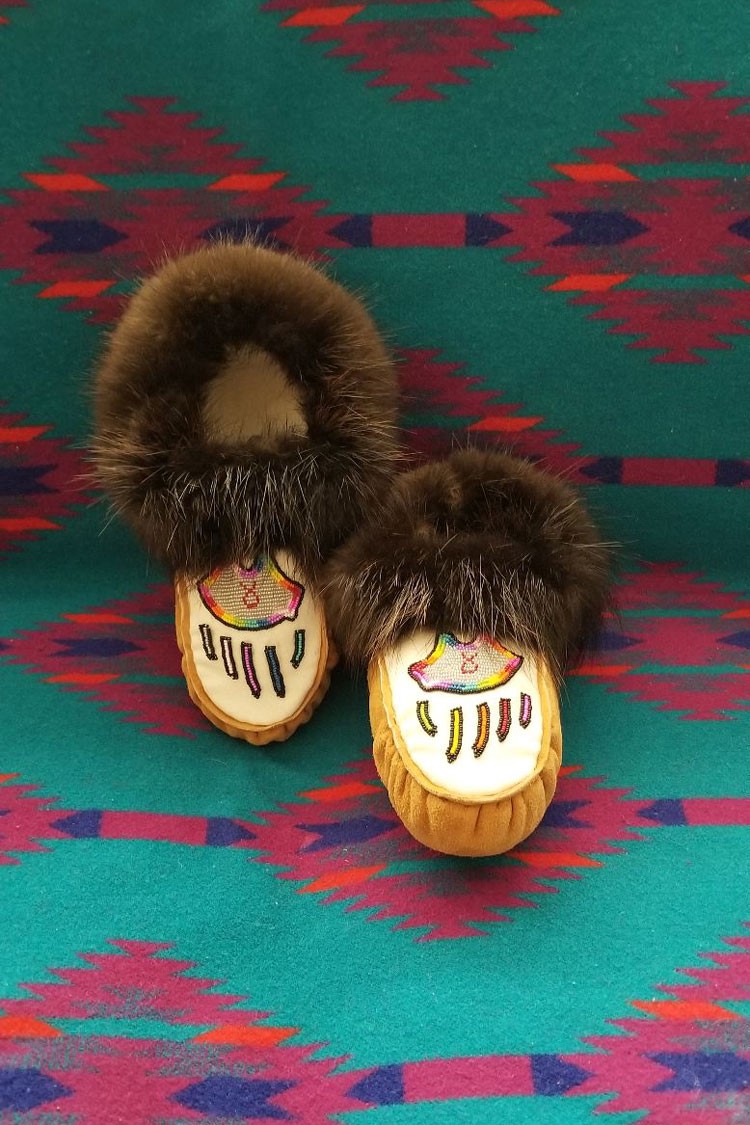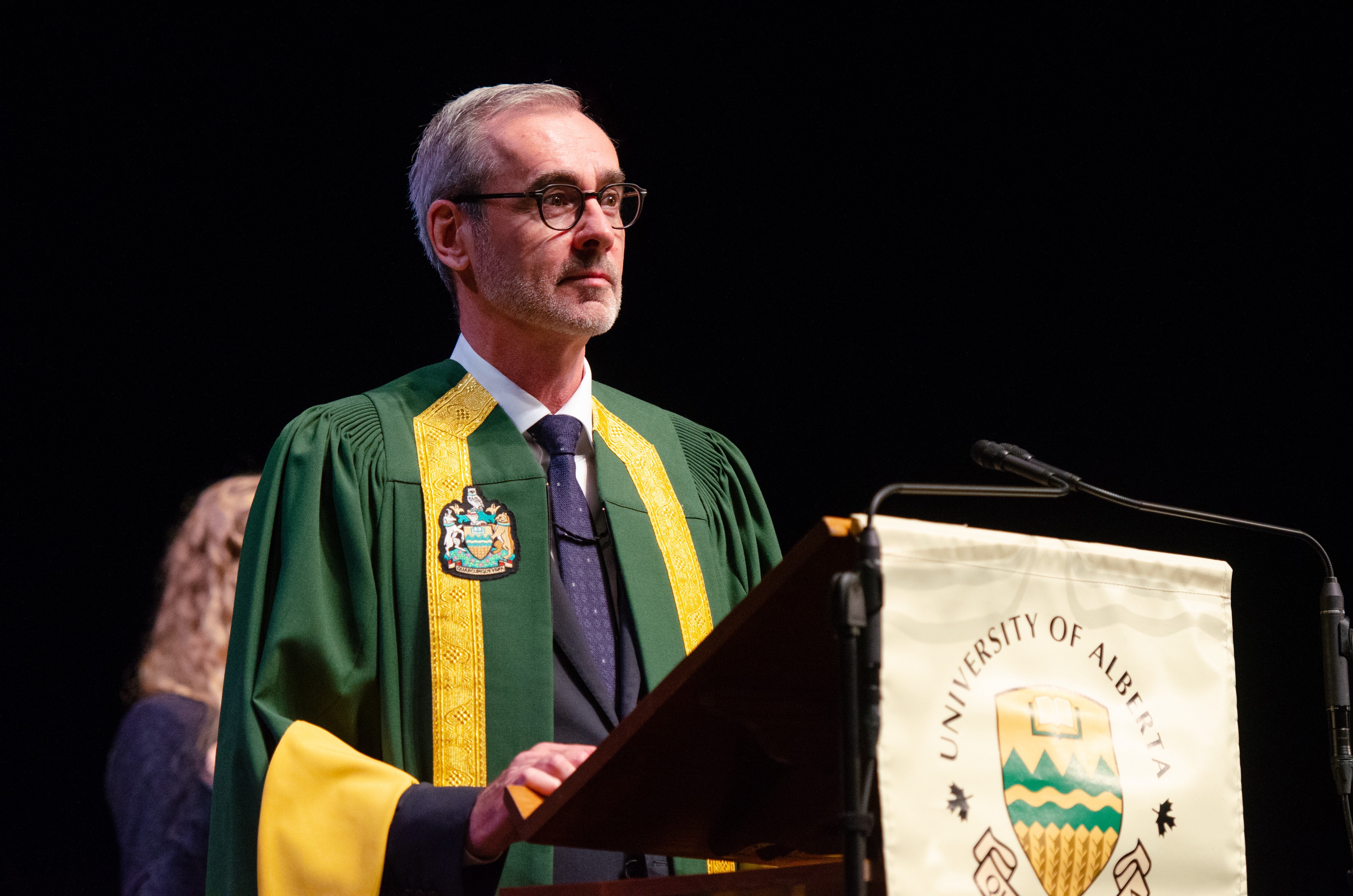
Bill Flanagan was installed as the 14th president and vice-chancellor of the University of Alberta on September 16, 2020. A recording of the ceremony is available.recording of the ceremony is available.
Eminent Chancellor Peggy Garritty, Lieutenant Governor Salma Lakhani, Board Chair Kate Chisholm, colleagues, family and friends.
COVID-19 has required that we carefully restrict the number of persons who can be present today. With that in mind, I would like to extend a particularly warm welcome to those viewing online who were unable to join us in person today.
Je souhaite également la bienvenue aux membres francophones de la communauté de l’Université de l’Alberta, en particulier à nos collègues et étudiants de la Faculté St. Jean. Nous apprécions grandement votre présence et le rôle important que vous jouez dans l’importante de programmes postsecondaires en français en Alberta.
[I would also like to welcome the Francophone members of the University of Alberta community, particularly our colleagues and students at the Faculté St. Jean. We greatly value your presence and the important role that you play in providing a range of French-language post-secondary programs in Alberta.]
I would like to begin my remarks by acknowledging that the University of Alberta is located on Treaty 6 territory and homeland of the Métis, and respects the histories, languages, and cultures of First Nations, Métis, Inuit, and all First Peoples of Canada, whose presence continues to enrich our vibrant community.
This acknowledgement is particularly significant today as this is the first installation in the history of the University of Alberta where we include on this stage not only the Canadian flag and the provincial flag of Alberta, but also the Treaty Six and Métis flags, recognizing both the sovereignty and nationhood of these First Peoples. I would also like to thank Elder Francis
Whiskeyjack, Lyle Tootoosis, and Colin Raine, for their beautiful and
meaningful ceremony of a traditional flag song earlier today.
Although a small step, it is an important one in the university’s journey towards reconciliation with the Indigenous peoples who have lived on this land for thousands of years, and who through the treaty process, generously offered to share these lands with those who came to these lands from far away.
In 1967, construction began on Red Deer's iconic St. Mary's Church by unknown Indigenous architect Douglas Cardinal. So…www.folio.caBill Flanagan officially installed as University of Alberta's 14th president
In 1967, construction began on Red Deer's iconic St. Mary's Church by unknown Indigenous architect Douglas Cardinal. So…www.folio.ca
I would also like to thank David Sharpe for attending today and for his most generous remarks. David is a proud Mohawk and a member of the Mohawks of the Bay of Quinte. He is also a long-time dear friend and mentor to me.
A loyal graduate of Queen’s Law, where I served as dean for 14 years, David was a thoughtful and compassionate leader in helping me to guide Queen’s Law along the path of truth and reconciliation with the Indigenous peoples of these lands.
Among David’s many gifts, the one I treasure the most was the opportunity to meet and come to know his dear friend, Dr. Douglas Cardinal, the world-renowned Indigenous architect and U of A honorary degree recipient. Douglas grew up in Red Deer, and his first major commission as
an architect was the design of St. Mary’s Church in Red Deer. A profoundly moving building, its design is inspired by Indigenous traditions of respect and sensibility towards nature and the inseparable relationship between Indigenous peoples and the land.
Growing up in nearby Lacombe, my family occasionally attended church at St. Mary’s. As a boy, I was both fascinated and deeply puzzled by this remarkable building. I had never seen anything like it, and I did not understand it. Later in life, I came to learn of its architect and his unique vision. And as I began to learn more about the genius of Douglas Cardinal, I came to deeply appreciate the marvel that is St. Mary’s Church.
At Queen’s, I had the honour of granting Douglas an honorary degree. Douglas generously chaired a law school committee responsible for selecting a piece of Indigenous art to hang in the atrium of the law school. I was also deeply honoured and delighted to accept when Douglas invited me to participate in a sweat ceremony in Ottawa.
So, thank you, David, not only for introducing me to Douglas and affording me the amazing opportunity to come to know him but thank you for all you do to advance the Indigenous peoples of this land. Thank you as well for your generous mentorship. I look forward to many more years of working together.

Likewise, I look forward to coming to know better — and working closely with — the many remarkable Indigenous leaders of these lands. I am deeply honoured with the gift of the moccasins today. Thank you, Elder Dr. Francis Whiskeyjack, Shana Dion, Lana Sinclair and Janet Delorme.
Upon the generous invitation of alumnus Dr. James Makokis, I had the opportunity to participate in his recent Hide Tanning Workshop. I had the chance to see the great skill and attention that goes into the creation of the hides that made possible these beautiful moccasins.
And with these moccasins, I am embarking on a new journey here at the University of Alberta, a journey that I will endeavour with all my ability to walk in a good way — to advance to the best interests of the university and all the diverse communities that it serves.
I would like to thank the Jubilee Auditorium for generously offering to host today’s event with no rental fee. With COVID-19, we have, of course, carefully limited the numbers present today to minimize risk and ensure an appropriate degree of social distancing. So, although our numbers are small, I think that we have still managed to fill the auditorium with spirit and light.
And among those here today, I would like to extend a special thank you to my family members who were able to attend. My father was from a family of 12 in Medicine Hat, and my mother, who grew up on a farm outside of Blaine Lake, Saskatchewan, was from a family of nine. Both of my parents were enormously proud graduates of the Faculty of Education at the University of Alberta.
Sadly, both have now passed away. They would have been thrilled to share this day with me. But I carry with me their legacy of a lifetime committed to education as a means of opening doors and opening minds.
With such large families, this means that I have many cousins, more than I can count. We may have joked in the past that between the Flanagans and Horners, we could fill the Jubilee. Well, with today’s restrictions, we seem to have done so today, much to my delight. Welcome, all of you, and thank you for sharing today with me.
Among my family present, I would like to extend a particular welcome to my Aunt Kathleen McCorkell, my mother’s sister, who travelled from Saskatoon to be here today. Three years ago,my Aunt Kathleen and I visited Blaine Lake to tour the old family farm and the town. It was a memorable day, and I couldn’t quite believe it when I saw the tiny house in which they had lived. I asked my Aunt, “how is it possible that all nine kids fit into that house?” and she laughed and said, “It was a house full of love.” Thank you, Aunt Kathleen, for being here today.
The University of Albert is one of Canada’s very top universities. It is recognized for a student experience that is second to none and a research impact that places it among the great universities of the world.
I take on the role of president and vice-chancellor at a pivotal time in its long and distinguished history. It has fallen on me — and on all of the enormously talented members of the university community — to steward this great university — not only as it faces COVID-19 — but as it also grapples with unprecedented financial pressures.
But challenge is no stranger to the university and no stranger to the province.
When I look back to the founding of the university, in his first convocation address in 1908, President Tory spoke of the opportunity to found a great institution with a mission to create a “just institution” with “an intellectual and spiritual atmosphere in which prejudice and hatred” cannot live.
Recognizing the public mission of the university, he insisted that the university be connected “as closely as possible to the life of the people,” and the “uplifting of the whole people shall be its” goal. He closed his remarks with a pledge “to the people of this province to unite in heart and soul to administer this trust for the public good.”
The university’s core mission remains unchanged to this day. It is to advance — through our teaching, research, service and community engagement — in all ways possible the people of this province.
It is also to reaffirm our commitment to build and sustain an atmosphere in which, as President Tory described it, “prejudice and hatred” cannot live — that is — a university that is committed to the core values of equity, diversity and inclusion of all the peoples and communities that make up our remarkable university and beyond.
Building on this initial mission, the University of Alberta provided the teaching and research that powered the development of Alberta’s immense natural resources, including agriculture, forestry and energy. The university trained the teachers — including my parents — and health care workers, business and community leaders, scientists, lawyers and others — all of whom contributed to building this great province.
I think of my father, who, growing up in terrible poverty during the Great Depression, never imagined that he might have the opportunity to attend university. However, as part of the support offered to veterans after the war, he was able to attend the University of Alberta, living at St. Joe’s College and training to become a teacher.
It transformed his life and as a teacher, he went on to transform the lives of others.
Likewise, I think of my mother, who, as a young girl, had a great passion to become a teacher. With her undergraduate degree from the University of Saskatchewan, followed by her Bachelor’s in Education from the University of Alberta, she was able to pursue her passion, starting her teaching career in a one-room school in Sunnynook, Alberta. Like my father, as a teacher, she went on to transform the lives of others.

This is the University of Alberta story, one of opening doors and building opportunity for all the people of this province.
Today, the province is once again calling on the University of Alberta to lead the way as we rebuild our economy and develop new paths for growth and opportunity, ranging from artificial intelligence to new energy systems, thinking creatively about how to build an inclusive Alberta with opportunity for all.
I do not doubt that the University of Alberta will rise to this great challenge in a manner always consistent with its central mission — to uplift the whole people. With our students always top of mind, we will provide a learning experience that looks to the future, providing our students with all the skills and intellectual curiosity that will enable them to build Alberta’s economy of
the future — dynamic, innovative, inclusive and global.
With this mission in mind, we have launched an ambitious and bold program of academic and administrative restructuring, called the University of Alberta for Tomorrow.
With this plan, we will transform the academic and administrative structures of the university, achieving financial sustainability.
We will further enhance the student experience. We will make an even greater contribution to research that advances society, with a particular focus on cutting edge interdisciplinary work.
We will deepen our levels of staff engagement, all in support of the university’s core mission.
We will demonstrate that the University of Alberta is not only a leader in innovation and entrepreneurship in teaching and research, we are also a leader in thinking creatively and boldly about how to build the best possible university of tomorrow.
Looking forward, we have a remarkable opportunity to grow our enrolment, with the favourable demographic trends in Alberta and the many more students who will soon be graduating from high school.
We will sustain and grow our position as one of the top 100 global universities, continuing to draw students from around the world to study here.
I am greatly encouraged by not only the willingness — but also the enthusiasm — of the whole university community to pull together at this critical time and face our future with boldness and a firm resolve to turn our current challenges into a strategic transformation.
Together, we can renew and grow the university’s global leadership in higher education and research, continuing to play the central role that the University of Alberta has always played in driving economic growth, innovation and creativity for the public good of all the people of this great province and beyond.
In conclusion, I would like to thank the University of Alberta Museums staff for their creation of an online exhibition of a selection of the marvellous collection of art that the university has acquired over the past 100 years from its many generous donors. This exhibition was put together to commemorate today’s installation. I do hope you will take the chance to view it. The creative arts are an essential and enduring part of the core mission of the university to uplift the whole people, perhaps never more important than in the challenging times we face today. So, thank you to the talented University of Alberta staff for preserving this art and sharing it with the world.
Finally, a special thank you to my husband, Saffron Sri, who is with me on the stage today. The Alberta I grew up in would have been puzzled by a gay president arriving with his husband. I must say, I did wonder what my reception might be, and both Saffron and I have been deeply touched by the warm welcome that we have received not only from all members of the
university community, but in the broader Edmonton community and beyond.
I want all members of the university community, whatever their path, whatever the remarkable diversity and difference they may bring to campus, to experience the same welcome and know that we as a community value this diversity and hold close our commitment to building an inclusive university for all.
Thank you, everyone.
Merci à vous tous.